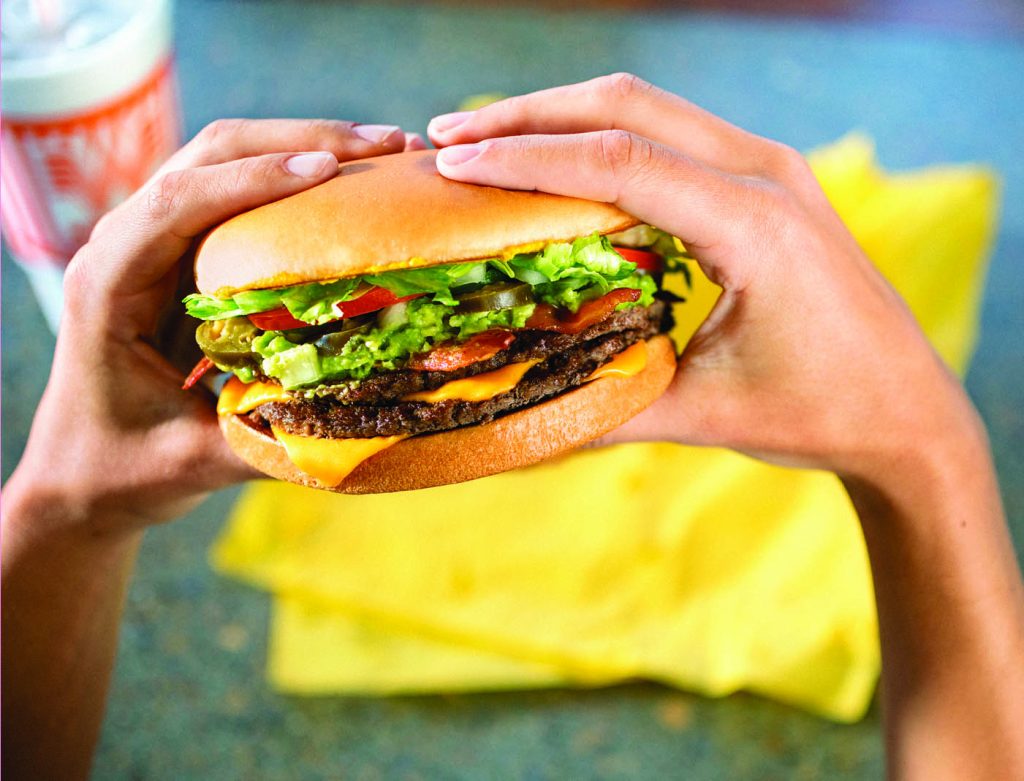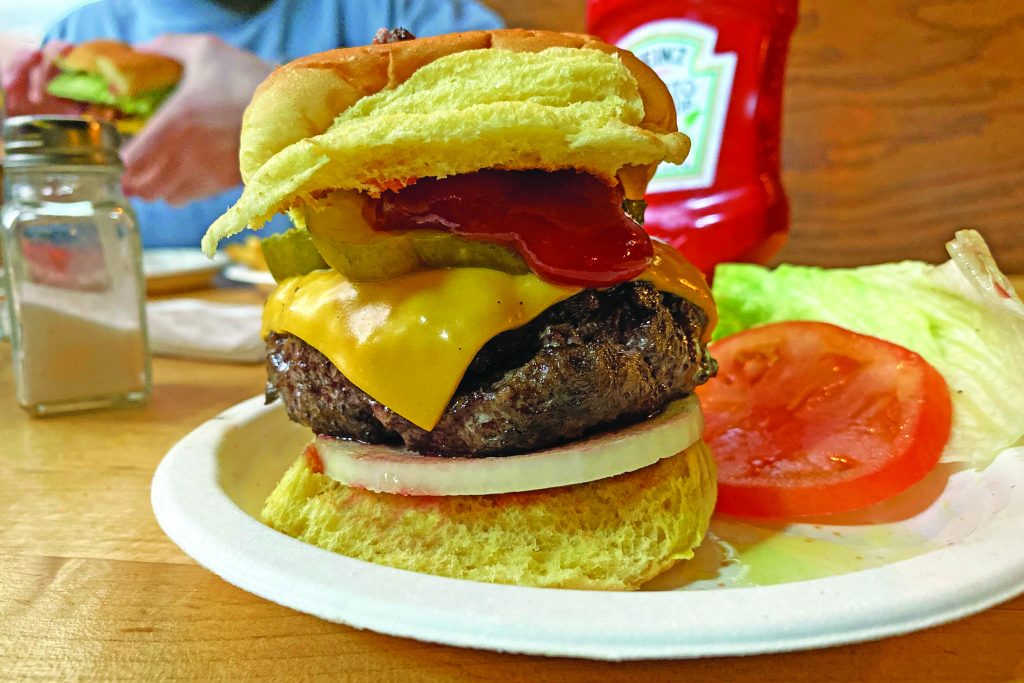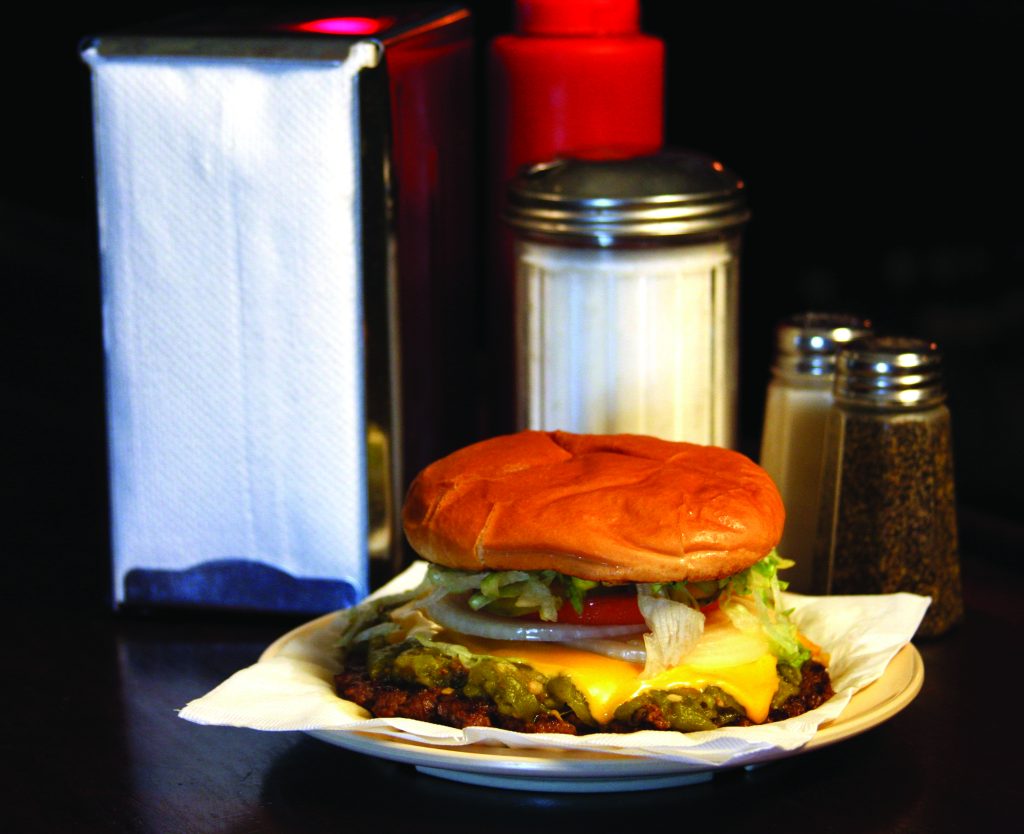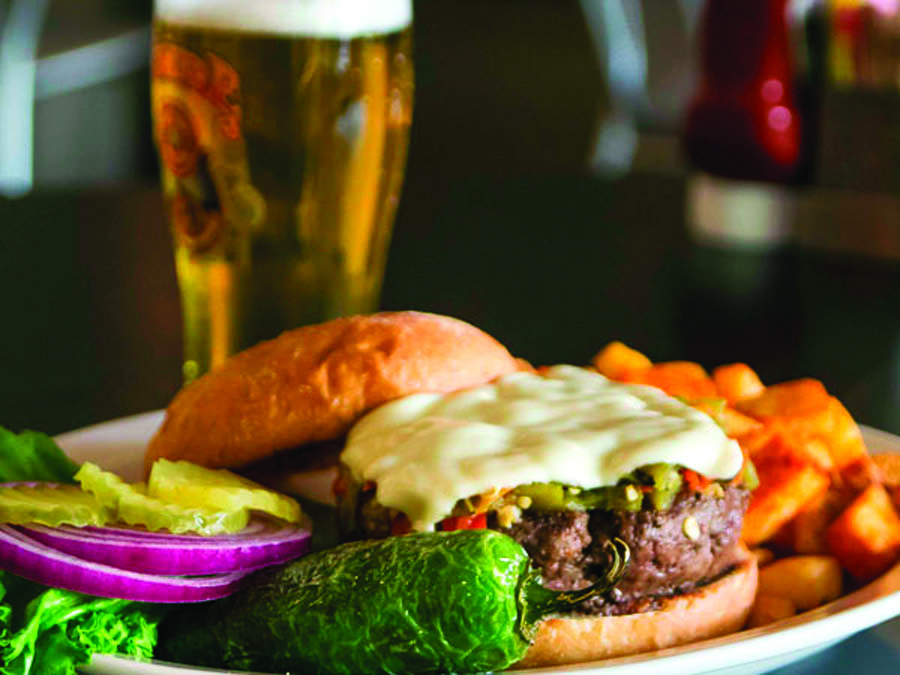While the hamburger may seemingly need little introduction, this American culinary icon has complex global ancestry.
In his encyclopedic 2017 book The World Is Your Burger: A Cultural History, British entrepreneur and burger obsessive David Michaels identifies ‘Isicia Omentata,’ an ancient Roman patty of minced meat, pep per, wine, pine nuts, and fish-based garum sauce as the genesis burger.
With other burgers vying for the early burger title, including the celebrated Middle Eastern kibbeh ball of bulgur, ground meat, and spices, and Mongolian horse meat and mutton tartare in the 13th century, Germany emerged as the cradle of the modern hamburger.
Precursors include the round rundstück warm roll with pork and hot gravy arising in the 17th century in the port city of Hamburg. The classic meatball patty frikadelle debuted in Berlin in the 1700’s as the boulette. The story resumes in Hamburg, where U.S.-bound immigrants in the mid 1800’s carried the city’s namesake “steak” of raw spiced minced beef for sustenance while crossing the Atlantic.
“Hamburg steak” soon appeared at food stalls, on restaurant menus, and in cook books, setting the stage for America to make this historic concept its own.
Who created the hamburger? Leading contenders include 15-year-old Charlie Nagreen, selling flattened ground beef and onions between two pieces of bread at an 1885 county fair in Seymour, Wisconsin. Other historians back “Uncle” Fletcher Davis of Athens, Texas, who showcased his 1880’s ground beef patty on a hot buttered bun at the 1904 St. Louis World’s Fair. Strong claimants also include the Menches Brothers of Akron, Ohio, selling their beef patty sandwich at the Hamburg, NY county fair, also in 1885, and Oscar Weber Bilby of Tulsa, OK, who fed his family flame-grilled ground beef on a bun on Independence Day, 1891.
Juicily debated to this day, the hamburger evolved through entrepreneurial improvisation and ingenuity. Like fries and milkshakes, back stories serve as flavor some sides at these old-school hamburger havens for your next fast food fix, hangover helper, date night, or road trip.
In 1916, Walter Anderson of Wichita, Kansas began selling his prototypical mini-burgers, or sliders, from a repurposed streetcar. In 1921, he partnered with E.W. Ingram to launch White Castle, America’s first hamburger chain.
The hamburger dream came alive in South ern California as the food of an all-American cultural revolution of automobiles, architecture, signage, and good times. Hall of famers include the late Rite Spot in Pasadena, birth place of the cheeseburger around 1925. Bob’s Big Boy, pioneering the double-decker cheeseburger, originated in Burbank in 1936 as Bob’s Pantry. McDonalds was born in San Bernadino in 1940, followed in 1941 by Carl’s Jr. in Los Angeles and In-N-Out Burger, launched in Baldwin Park in 1948.
Others followed nationally through the decades, from Miami’s Insta-Burger King, renamed Burger King, in 1954, to star restaurateur Danny Meyer’s Shake Shack, launched as a hot dog cart in 2001. The latter recently extended its reach to the skies, partnering with Delta Air Lines to serve cheeseburgers in first class on select U.S. long-distance routes.

Whataburger (Photo by Whataburger)
My fast-food favorite, hands down, is Whataburger (whataburger.com). In fact, you will need all ten digits to devour this burger introduced by Harmon Dobson in 1950 at his humble stand in Corpus Christi, Texas that was “so big it took two hands to hold.” Early enthusiasts raved “what a burger!” after engulfing Dobson’s five-inch pure beef sandwich, birthing the “Texas Treasure” designated by the state legislature in 2001.
Skipping the lettuce and tomatoes, which I believe complicate any hamburger, the classic Whataburger, made-to-order with pickles, mustard, and diced onions, and spicy ketchup, delivers consummate mouthfeel satisfaction every time.
Whataburger’s 1,050-plus orange-and white striped restaurants, most open Corner Bistro Cheeseburger 24/7/365, extend across Texas and 15 other states, from Arizona to Florida. Corpus Christi locations include a replica of Dob son’s original stand and Whataburger by the Bay, featuring a bronze statue of Dobson.
Another pioneer in the “original” pool is Danish immigrant Louis Lassen, who started out serving steak sandwiches to New Haven, Conn. factory workers in 1895 from his horse-drawn wagon. In 1900, according to legend, a customer in a rush commanded Lassen to “slap a meat puck between two planks and step on it!” Lassen obliged by sandwiching loose steak trimmings on toast, birthing, as designated by the Library of Congress, the “Hamburger Sandwich.” Purists hold that the burger must meet the bun to be authentic, which puts Davis and Bilby ahead of Lassen. Still, Louis’ Lunch (261 Crown Street, New Haven, CT. Tel. 203-562- 5507. louislunch.com), Lassen’s tiny restaurant from 1917, relocated nearby in the 1970’s and is run today by his great-grandson Jeff. Still flamed in three vertical cast-iron broiler stoves from 1898, the one and only “Original Burger” comes diagonally-sliced on toasted white Pepperidge Farm bread. Add-ons include tomato, cheese, and onions. No ketchup—as the sign says, don’t ask.
I discovered Corner Bistro (331 W 4th St, New York, NY. Tel. 212-242-9502. corner bistrony.com) right after arriving in Manhattan in 1987, and like generations of New Yorkers before and after me, fell in love with the West Village bohemian bastion and its burgers, which New York Times food critic Mimi Sheraton ordained as among NYC’s best in 1978.

Corner Bistro Cheeseburger (Photo by Jeff Heilman)
The early 1900’s three-story brick building’s lusty lineage includes hiding a speakeasy behind a butcher shop during Prohibition, and a late 1950’s spell as the Frisco brothers’ eponymous gay bar, which ended on a morals charge when they refused to pay protection money to the mob. In 1961, helped by her friend New York Governor Nelson Rockefeller, local writer Tania Gomez launched Corner Bistro as a French restaurant in the space. Cooked in the definitive postage stamp kitchen, the burgers first appeared in 1967. Squeezing into a booth in the back room for the bacon-topped Bistro Burger with cheese, pickles, fries, and beer is my forever NYC touchstone.
San Francisco’s original Hamburger Mary’s (hamburgermarys.com) from 1972 has even more illustrious gay lineage. Possibly named after a Williams Burroughs character—the Beat legend frequented a 1930’s Midtown Manhattan restaurant run by native San Franciscan “Hamburger Mary” Morris—the ground breaking burger joint debuted as an “open air bar and grille for open-minded people,” its motto to this day.
Founded by gay and hippie restaurant workers, the after-hours haunt became a South of Market (SoMa) fixture alongside Folsom Street’s leather bars before closing in 2001. The name and concept lived on, operating today as LGBTQ-themed locally-owned independent franchises. At coast-to-coast locations including West Hollywood, Las Vegas, Dallas, and Orlando, patrons are invited to “Eat, Drink, and Be…Mary!” with drag shows, brunches, bingo, and other high-energy interactive entertainment. Burgers rule the much-expanded menu, from the original Mary Burger to saucy riffs such as Buffy the Hamburger Slayer, Guacamole B.J., Black & Blue Boy, and Barbara-q Bacon Burger.
New Jersey is the capital of another American institution, the diner, with two nationally acclaimed historical havens for hamburgers across the Hudson River from NYC. The UFO-shaped structure housing White Mana Diner (470 Tonnelle Avenue, Jersey City, NJ. Tel. 201-963- 1441.whitemanadiner.com) was manufactured for the 1939 World’s Fair in Queens, NY as “the diner of the future” and an “Introduction to Fast Food.” In 1946, owner Louis Bridges relocated the diner to its present location on a gritty industrial corridor. Time capsule interiors including the wagon wheel ceiling, wraparound counter, and fresh meat sliders, call pilgrims to this day.
Bridges expanded in the 1940s, but only White Manna (358 River Street, Hackensack, NJ. Tel. 201-342-0914. whitemanna.com) in Hackensack survives. With the painter reportedly having forgotten the second “n” in the flagship, it’s more manna from hamburger heaven here in hand-crafted sliders with cheese and grilled onions served on a Martin’s potato roll.
In New Mexico, the Land of Enchantment, the green chile cheeseburger (GCCB) is a culinary calling card. Originally grown by Pueblans, green and red chile peppers are the state’s nationally dominant signature crop. Leading production centers include the Hatch Valley, the “chile capital of the world,” where the “New Mexico 9” chile pepper, sweeter and smoother than its indigenous ancestors, has been cultivated at New Mexico State University since 1913.
In 2023, the tantalizing smell of roasting chiles became the official state aroma, following designation in 1996 of “Red or Green?” as the official state question, referring to one’s preference for red or green chiles (“Christmas” for both) when ordering New Mexican dishes. Green chiles, ubiquitous in New Mexican cui sine, first landed on hamburgers in the 1940s at two kitty-corner heirlooms in tiny San Antonio, NM, birthplace in 1887 of Hilton Hotels founder Conrad Hilton.

Owl Burger (Photo by New Mexico True)
In 1948, World War 2 Navy veteran Frank Chavez and his wife Dee opened Owl Bar & Cafe (77 US Highway 380. Tel. 575-835- 9946. sanantonioowl.com) at Dee’s father’s 1930’s mercantile store and served their first Owl Burger to Manhattan Project atomic scientists from Los Alamos disguised as prospectors. Topped with proprietary green chile sauce, this juicy flavor bomb remains the hot ticket at the fourth-generation family-owned Owl, which features an original Hilton family mahogany bar.
Dating to 1918, the Buckhorn Tavern (68 US Highway 380. Tel. 575-835-4423. buckhornburgers.com) introduced its own GCCB around the same time. In 2009, former owner Bobby Olguin defeated Bobby Flay in the Food Network’s “Green Chile Cheese burger Duel.” The ensuing publicity raised lasting national awareness of the culinary attraction.
Introduced that same year, New Mexico Tourism’s Green Chile Cheeseburger Trail (newmexico.org) lists the state’s top GCCB restaurants, diners, dives, drive-ins, cafes, and roadside stands.
Other landmarks include Blake’s Lotaburger (3207 Richmond Dr. NE, Albuquerque. Tel. 505-884-2530). Founded in 1952 by WW2 Navy veteran Blake Chanslor, this Albuquerque original, now a three-state chain, earned “Best Green Chile Cheese burger in the World” recognition from National Geographic in 2006. Kitschy eatery and live entertainment temple Sparky’s Burgers and BBQ (115 Franklin Street. Tel. 575-267-4222. sparkysburgers.com) in Hatch reached the 2020 James Beard semi finalist round for its scratch-made GCCBs.
Launched in 2013, Santa Fe’s annual September Green Chile Cheeseburger Smack down (ediblesmackdown.com) is is a sellout foodie fest. New Mexico’s historic high-altitude capital, where I had my first GCCB that same year, is a hotbed for the wonder burger.

Green Chile Cheeseburger at Santa Fe Bite (Photo by Tourism Santa Fe)
My friend Bobby Beals, a fifth-generation Santa Fean and artist-entrepreneur, swears by the signature “Skinny” at fellow Santa Fean Josh Gerwin’s “rockin’ fresh New Mexico fusion” restaurant Dr. Field Goods (187 Paseo De Peralta. Tel. 505-982-3033. drfieldgoods.com). Meanwhile, Iconic former GCCB temple Bobcat Bite lives on as Santa Fe Bite (1616 St. Michaels Drive, Santa Fe. Tel. 505- 428-0328. santafebite.com).
Neighboring Nevada is another expansive hamburger state. Thirty minutes south of Las Vegas in the ghost town of Goodsprings, the 1913 Pioneer Saloon (310 W Spring Street. Tel. 702- 674-6809. pioneersaloonnv.com) is worth the drive for the Ghost Burger and kicking your boots up.
This landmark from the area’s mining heyday is among Nevada’s oldest watering holes, attracting bikers, cowboys, and other colorful characters. One wall of the Sears and Roebuck tin-stamped interior features three bullet holes from a 1915 poker game turned deadly. After Carole Lombard perished in a nearby plane crash in 1942, her husband, Clark Gable, sat anguished at the bar awaiting the heart-breaking news. Tributes to her memory are enshrined in a back room. Every week now, there’s live music, cold beer, and the zesty Ghost Burger with jalapeno bacon and secret Ghost sauce.
Wherever you motor in America, historic burger beacons beckon. Roanoke, nestled in the Blue Ridge Mountains of southwest Virginia, is home to the Texas Tavern (114 West Church Avenue. Tel. 540-342-4825. texastavern-inc.com). Founded in 1930 by Issac N. (Nick) Bullington, an advance man for the Ringling Brothers circus, this time capsule throwback is for the original chile burger, from a San Antonio, Texas hotel, and the egg-topped Cheesy Western burger.
The exciting and delicious hamburger trail in the USA leads in all directions, so let hunger for history be your guide wherever you go.


